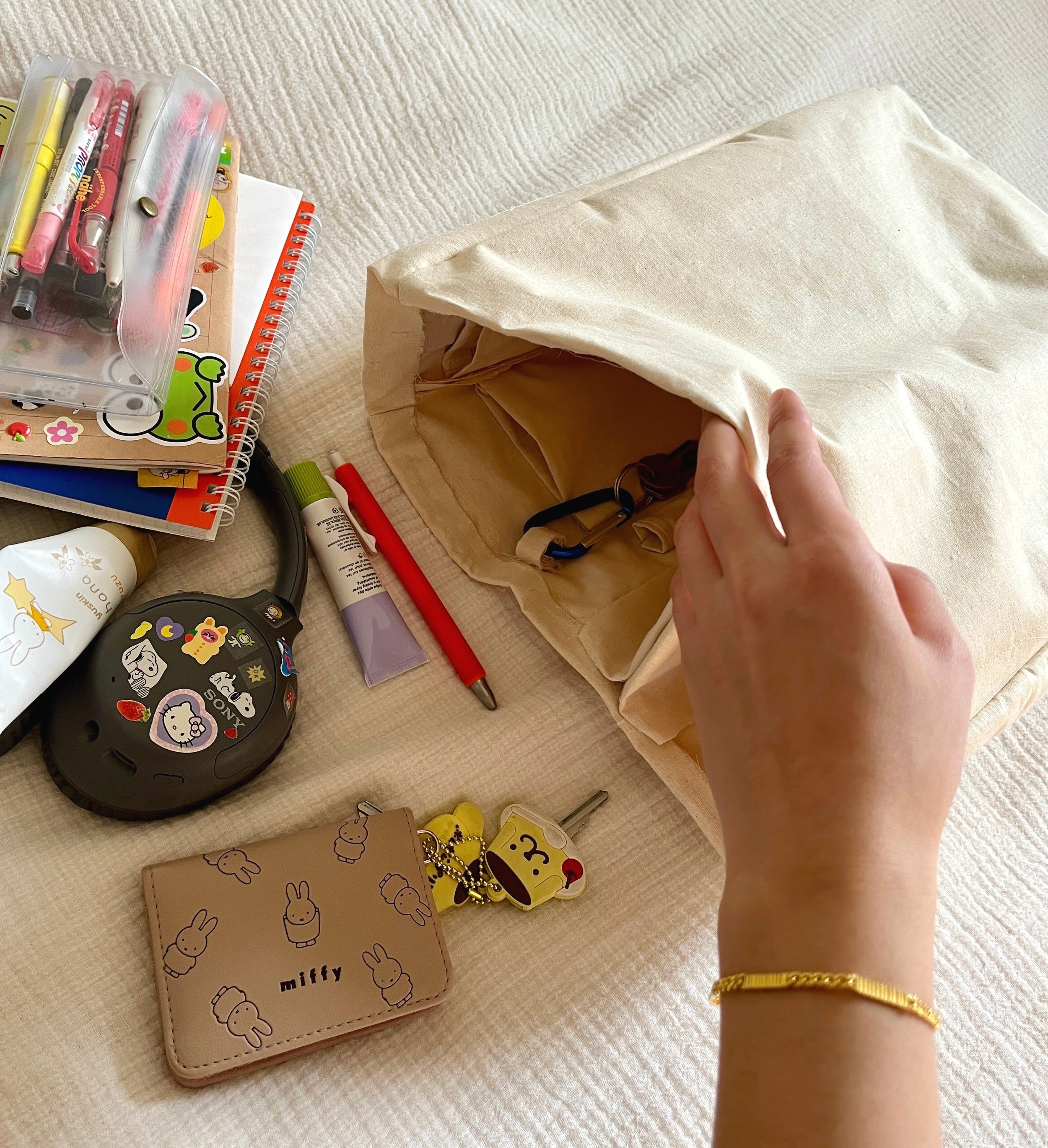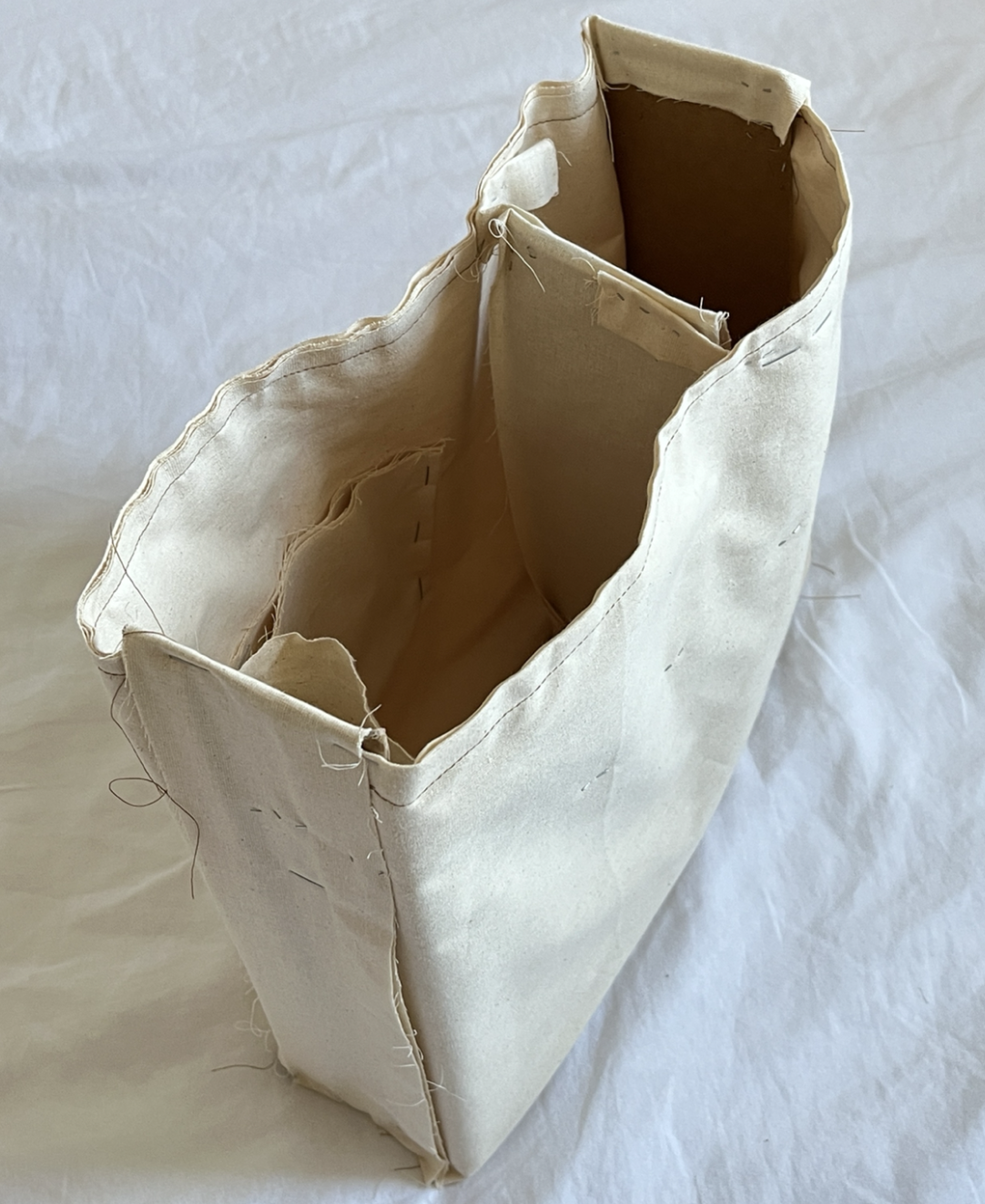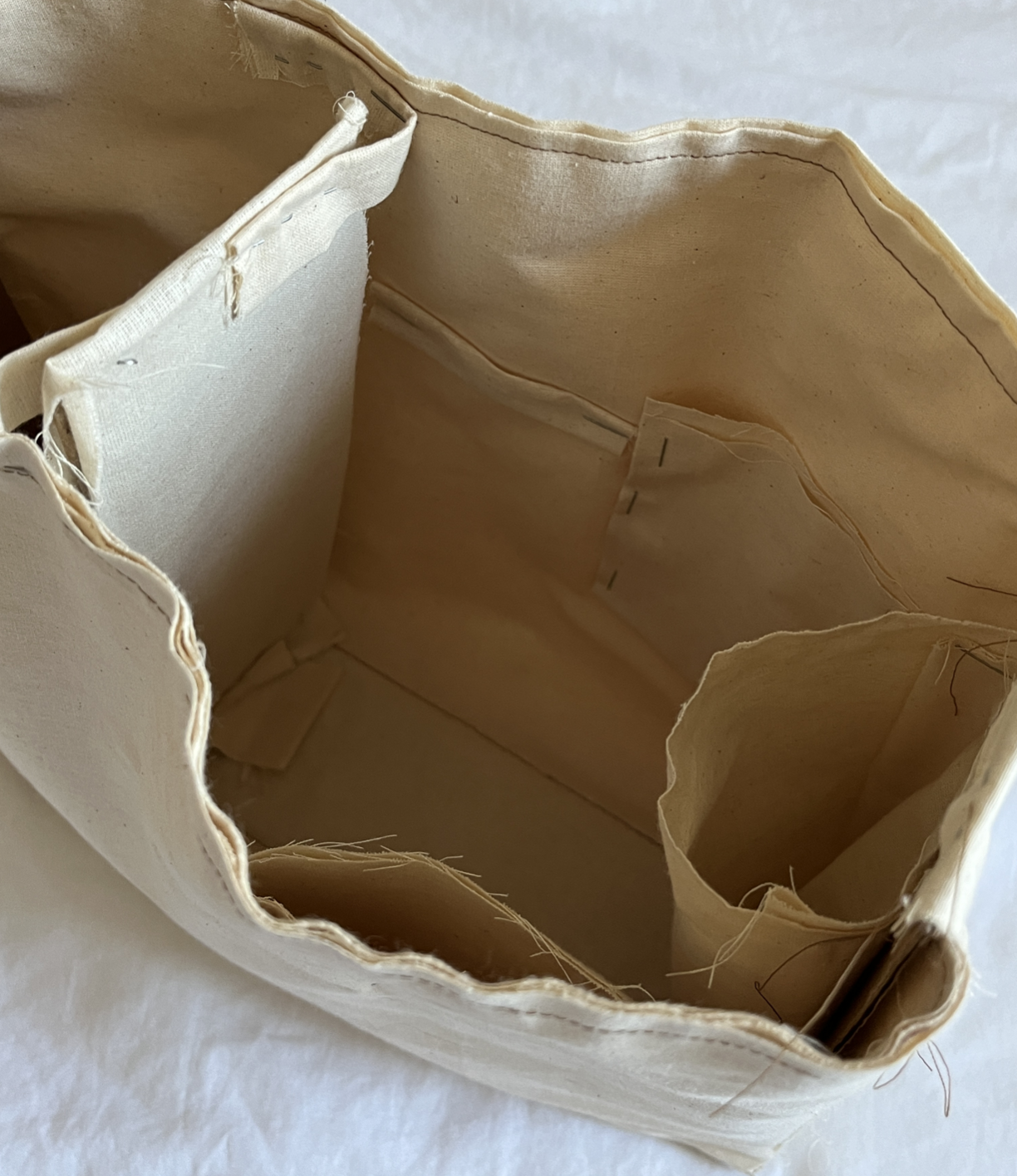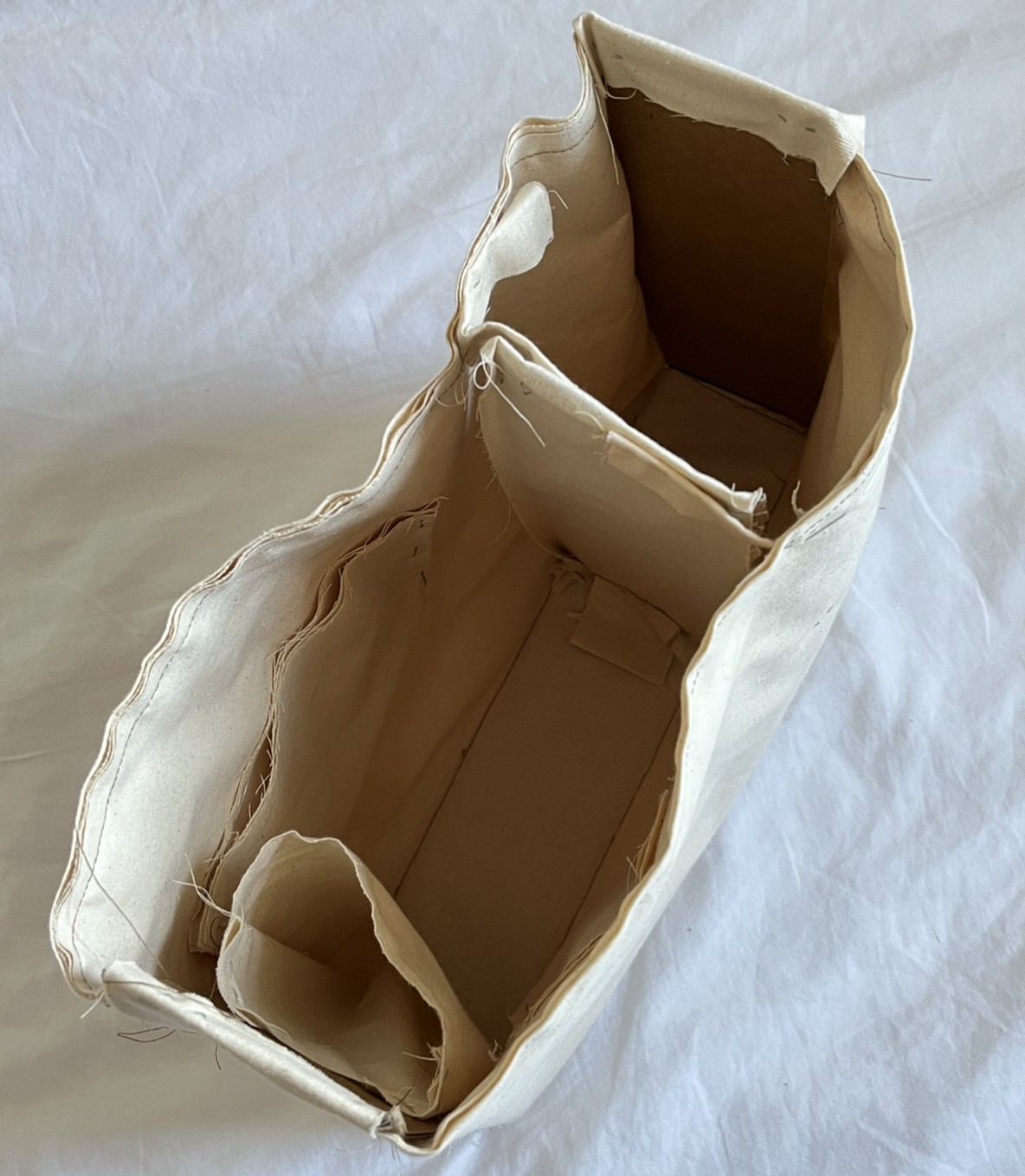
Tote Organizer
April 2024
Role: Product Designer
Type: Product Prototype
Picture this: you’re packing your everyday carry items for a day out, but realizing that all you’re really doing is throwing everything you think you might need and more into the black hole that is your tote bag. And later, when you actually have to get something out, you end up rummaging through your bag for what seems like way too long and end up forgetting what you were even looking for…
Though tote bags are really easy to grab on the go and carry around, it’s still hard to find and retrieve things in because the bag is essentially one big pocket that cannot store things in one specific place, upright, or in a way that is easy to locate. So, having an appropriate, visible, and distinct place for everyday carry items in a tote bag would help make this process less cumbersome.
Final Prototype
Product Proposal + Background
The tote bag organizer should have various compartments and features that will be gathered from user interviews. After conducting the interviews, a list of needs that users have for a tote bag organizer will be compiled and prototyping can begin. The tote bag organizer is intended for users of tote bags who need more organization inside the bags for easy access to items, such as laptop, wallet, and water bottle or cup. The biggest risks will probably be deciding on what compartments will be integrated and the sizing of such, as people have varying laptop sizes, notebook sizes, water bottle sizes, etc., so making things adjustable or accommodating for most will be important to analyze via prototyping and user feedback sessions.
Tote bags can be handy to use on the go, as they are simple in design, versatile, and flexible for various situations, like grocery shopping or going out for a walk. However, item organization and obtainment on the go can be difficult, as most tote bags are just one big pocket. Items can move around in the bag throughout the day, and it can be inconvenient and time consuming to have to dig through a tote bag and a number of items to find a singular one.
Though the addition of an inner or outer pocket can be useful, it is still not designated for certain items, so things can get lost in those as well. Having experienced this firsthand and seeing how my friends have interacted with their tote bags, it could take awhile to fish out apartment keys, a pen, or headphones among the extra sweater, book, snack, water bottle, and toiletry bag, for example, in the bag. Providing distinct places for items inside a bag could allow users to have an optimized item organization and retrieval experience.
From the user interviews, six different designated compartments for six main everyday carry items–phone, wallet, keys, headphones/small compact items, wallet, and laptop. From the dimensions of a standard 15” x 15” tote bag, four different pockets were created and sewn into a tote bag organizer that measured 12” x 12”. These four pockets were for a phone, water bottle, headphones/small items, and wallet/ larger items. A key clip was also included in the prototype but did not make it to the usability test, as it was not secure enough on the fabric (was removed). An area for pens to be attached to via pen clip was also included. A laptop could be placed outside of the organizer in the tote for easy access and upright storage.
The testable prototype was made out of muslin fabric that was triple layered and had inserts for cardboard at the bottom and two narrow sides for support. The cardboard was placed into an insert in the muslin rather than sewn into the muslin to allow for removal for washing/care and compact storage of the tote organizer. In addition to using a sewing machine, due to space and resource availability, most of the fabric was stapled together.
A Testable Prototype
Product Feedback
The first step in the design process consisted of user interviews to get a feel of what users would need and want via Google Forms. The following prompts/questions were included in the interview questionnaire:
Name
Age
Occupation (if student, state what school)
Where do you live? (city, state)
How often do you use tote bags on a scale of 1-5, with 1 being never and 5 being always?
What are your everyday carry items?
Walk me through the process of how you get ready to head out for a typical day, with consideration to your everyday carry items, how you carry them, etc.
How do you decide when to bring a bag with you when going out and what kind of bag to bring?
What is most important for you when considering what kind of bag to carry (can choose more than 1 option):
☐ organization: lots of pockets
☐ convenience: things are where they should be and easy for me to get
☐ large storage space
☐ lightweight
☐ compactness
☐ efficiency: it will only carry what I need
☐ style/aesthetic
☐ security: zippers, button closure
☐ otherWhat do you think can make the process of organizing your tote bag easier for you?
Any other questions, feedback, etc.?
Eight responses were collected and the participants ranged from 20-45 years of age (median = 24.75 years). Three out of the eight participants stated they were students in college (undergraduate) while the others are all employed full-time. Three reside in Boston, while the rest live in New York City. 37.5% of users said they use a tote bag most of the time (rank 4), while 25% use a tote bag always (rank 5), 25% occasionally use one (rank 2), and 12.5% sometimes use a tote (rank 3). The respondents’ everyday carry items did vary, as expected, but there were many items in common, such as phone, wallet, keys, water bottle, AirPods/headphones, toiletry bag, computer, lip balm, and gum. Users also noted that the type of bag they choose depends on their intended activity, style/aesthetic, and how much they need for the intended activity. A majority of users prioritize the organization (87.5%), style/aesthetic (87.5%), convenience (75%), and lightweight-ness (62.5%) of what kind of bag they decide to carry. All users mentioned pockets of different/various sizes in answering how the process of organizing a tote bag can be made easier, with high consideration to pockets with designated purposes.
It was gathered that the three participants from a usability testing session (three participants) that their habits corresponded with those from the user interviews. Two usability testers described how they do not use a tote bag because it is not organized at all, they carry too many things, or they would rather use a backpack, while one usability tester is a dedicated tote bag user but needs some organization system to make her life easier. Furthermore, two testers responded saying that they would just throw their everyday carry items into a tote bag because there is no organization and even if they ordered things, they would move around eventually (which all three agreed upon). All three testers were able to successfully use the tote bag organizer prototype, and were overall satisfied with the designated pockets and being able to remember where they put what.



Final Prototype
The final product design includes all pockets from the previous prototype, with a modified pen pocket and a loop for a carabiner. The materials were the same and dimensions were approximately the same. All pieces were either sewn together or hot glued, instead of stapled.
Future Work Summary
If the timeline of the project were to be extended by three weeks, I would create a paper template for each piece of fabric and cardboard so that each organizer can be a consistent size. I would also purchase and use a 10 oz duck cotton canvas instead of layers of muslin for durability and longevity of the product. Instead of cardboard, I would try using interfacing to make the sides more rigid without extra weight. I would also alter the assembly process, as for the prototypes I could have been more precise and spent more time sewing and glueing pieces together. I would sew in all pockets onto the sides first, then sew the larger side panels together. I would also experiment with pocket closure methods (velcro, buttons, zippers) and creating a better key attachment.




